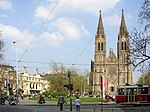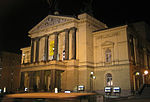Náměstí Míru (Prague Metro)

Náměstí Míru (Czech pronunciation: [ˈnaːmɲɛsciː ˈmiːru], English: Peace Square) is a Prague Metro station on Line A. It is located in Vinohrady district under Korunní Street and has one exit through an escalator tunnel with a sub-surface vestibule under the plaza of the same name. The exit of the metro station is in the immediate vicinity of the Church of St. Ludmila and Vinohrady Theatre. The station was completed along with the first section of Line A, between Leninova and Náměstí Míru, and opened on 12 August 1978. It served as a terminus until the extension of Line A to Želivského station on 19 December 1980.Náměstí Míru is the deepest station of the Prague Metro and the European Union. Its platform is situated 53 metres below surface. The station has also the longest escalators in European Union (length 87 m, vertical span 43.5 m, 533 steps, taking 2 minutes and 21 seconds to ascend or 2 minutes 19 seconds to descend without walking). Náměstí Míru, however, is not the deepest point within the Prague Metro network; this record belongs to the tunnel between Hradčanská and Malostranská stations (68 m below surface). The station is named after the square under which it is located. It was the terminus in August 2002 due to flooding.
Excerpt from the Wikipedia article Náměstí Míru (Prague Metro) (License: CC BY-SA 3.0, Authors, Images).Náměstí Míru (Prague Metro)
náměstí Míru, Prague Vinohrady
Geographical coordinates (GPS) Address Website Nearby Places Show on map
Geographical coordinates (GPS)
| Latitude | Longitude |
|---|---|
| N 50.0753325 ° | E 14.43769 ° |
Address
náměstí Míru
120 00 Prague, Vinohrady
Prague, Czechia
Open on Google Maps








